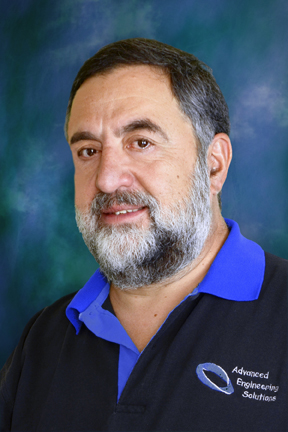
Dr. Andreas Vlahinos believes it’s time to revamp CAD modelers to support additive manufacturing.
Latest News
April 14, 2015
 Dr. Andreas Vlahinos believes it’s time to revamp CAD modelers to support additive manufacturing.
Dr. Andreas Vlahinos believes it’s time to revamp CAD modelers to support additive manufacturing.Dr. Andreas Vlahinos, principal of Advanced Engineering Solutions, observed, “Today’s CAD systems were developed based on how you machine parts, for subtractive manufacturing. But 3D printing [additive manufacturing] is a totally different paradigm.”
This is evident in, for example, the way CAD deals with shelled parts, Vlahinos pointed out. “When you use the Shell command in most CAD programs, it fills the void with air,” he explained. “It doesn’t let you fill the empty space with lattice structure. What I would want [in a part to be 3D-printed] is the option to say, Fill the space with cross-hatches or tetrahedral structure.”
In 3D printing, the part is built from the ground up in layers. Therefore, a void or a discontinuation in vertical mass must be supported with some type of temporary structures (usually dissolved or removed in the cleanup process). Current CAD systems are not designed to recognize such instances and automatically generate the necessary support structures.
“The current workaround is to fill such gaps with a pattern,” Vlahinos said. “That works great for 2D or 2.5D design, but not for 3D.”
Such support structures may be omitted with smaller parts (at the scale of toys), but the current engineering investigation of 3D printing has to do with its potential for printing large complex parts (for example, aerospace components). At this scale, support structures are a must to prevent parts from collapsing during the printing process.
The other problem that Vlahinos identified with CAD programs is, in his words, “their inability to convert STL geometry into smooth NURBS geometry.”
This could potentially become a hurdle in simulation-driven topology optimization, as the computer-proposed “optimal” form invariably includes surfaces and jagged edges unsuitable for manufacturing—neither in additive nor in subtractive—without further refinement.
“At the moment, no CAD system is ready for 3D printing, but some show promise,” said Vlahinos.
Vlahinos doesn’t think most manufacturers would be willing to add a new CAD system to their operational burden just to accommodate 3D printing. “We’ll need to choice of designing for 3D printing or machining in the same CAD package,” said Vlahinos.
This is a quandary for CAD developers as well, since writing a new CAD system from the ground up to use for 3D printing might be a lot easier than rewriting their existing subtractive-friendly modeler to support additive manufacturing.
Vlahinos is part of the team presenting the findings from the latest Analysis, Simulation, and Systems Engineering Software Summit (ASSESS) at COFES 2015 (April 16-19, Phoenix, Arizona).
Subscribe to our FREE magazine, FREE email newsletters or both!
Latest News
About the Author
Kenneth Wong is Digital Engineering’s resident blogger and senior editor. Email him at [email protected] or share your thoughts on this article at digitaleng.news/facebook.
Follow DE





